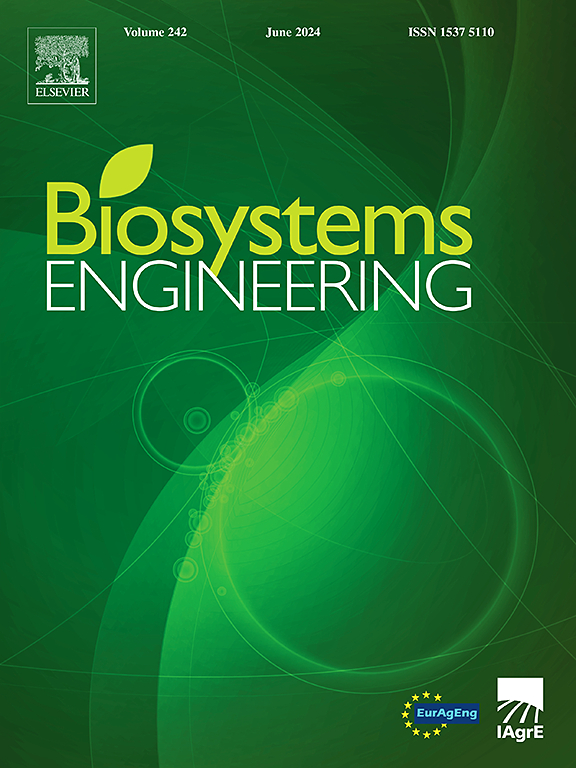Effect of different sizes and percentages of dockage on physical properties of stored wheat mixtures
IF 4.4
1区 农林科学
Q1 AGRICULTURAL ENGINEERING
引用次数: 0
Abstract
To answer which dockage size and its percentage mostly influence grain physical properties during grain handling and storage, the effects of dockage size and percentage on the physical properties of wheat mixtures were studied. Wheat mixtures including three different dockage sizes (≤1.0 mm, 1.1–2.0 mm, and >3.35 mm) and four varying percentages (0, 2.5, 5, and 10 %) at moisture content between 13.2 % and 13.4 % (wet basis) were tested. The measured physical properties were bulk density, kernel density, porosity, angles of repose (both filling and emptying), internal friction coefficient, cohesion, and coefficients of friction on surfaces of wood-floated concrete, plastic, galvanized steel, and plywood. Both bulk and kernel densities decreased exponentially with increasing dockage percentages, while porosity exhibited an exponential increase, reaching up to 65.1 %. Small and large size dockage significantly raised the filling and emptying angles of repose as dockage percentages increased, and this trend was not observed on the medium size dockage. Cohesion increased and internal friction decreased with the increase of dockage percentage, particularly in the mixtures with small size dockage. The coefficient of wall friction for clean wheat (0 % dockage) was highest against wood-floated concrete and lowest against galvanized steel. The roughness of the tested surfaces and the particle density of the mixtures explained the complex trend of coefficient of friction on different surfaces. These conclusions provided the basic information and guideline for grain industry on grain cleaning during handling and storage.
不同贮藏尺寸和百分比对混合小麦物理特性的影响
为了回答在粮食处理和贮藏过程中,滞留度和滞留率对籽粒物理性质的影响最大,研究了滞留度和滞留率对混合小麦物理性质的影响。小麦混合物包括三种不同的包装尺寸(≤1.0 mm, 1.1-2.0 mm和>;3.35 mm)和四种不同的百分比(0、2.5、5和10%),水分含量在13.2%和13.4%之间(湿基)。测量的物理性能包括体积密度、核密度、孔隙率、休止角(填充和清空)、内摩擦系数、粘聚力和木浮混凝土、塑料、镀锌钢和胶合板表面的摩擦系数。随着堆积率的增加,体积密度和粒密度呈指数级下降,孔隙度呈指数级增加,最高可达65.1%。小、大尺寸船坞随船坞百分比的增加而显著提高了船坞的充、空角,而中尺寸船坞则没有这种趋势。黏结力随黏结力百分比的增加而增加,内摩擦随黏结力百分比的增加而减小,特别是在小尺寸黏结力的混合料中。清洁小麦(0%淤积)的墙体摩擦系数与木浮混凝土的摩擦系数最高,与镀锌钢的摩擦系数最低。被试表面的粗糙度和混合物的颗粒密度解释了不同表面摩擦系数的复杂趋势。这些结论为粮食行业在处理和储存过程中对粮食进行清洗提供了基本信息和指导。
本文章由计算机程序翻译,如有差异,请以英文原文为准。
求助全文
约1分钟内获得全文
求助全文
来源期刊

Biosystems Engineering
农林科学-农业工程
CiteScore
10.60
自引率
7.80%
发文量
239
审稿时长
53 days
期刊介绍:
Biosystems Engineering publishes research in engineering and the physical sciences that represent advances in understanding or modelling of the performance of biological systems for sustainable developments in land use and the environment, agriculture and amenity, bioproduction processes and the food chain. The subject matter of the journal reflects the wide range and interdisciplinary nature of research in engineering for biological systems.
 求助内容:
求助内容: 应助结果提醒方式:
应助结果提醒方式:


